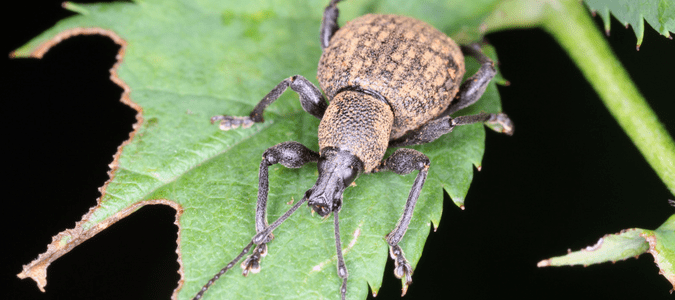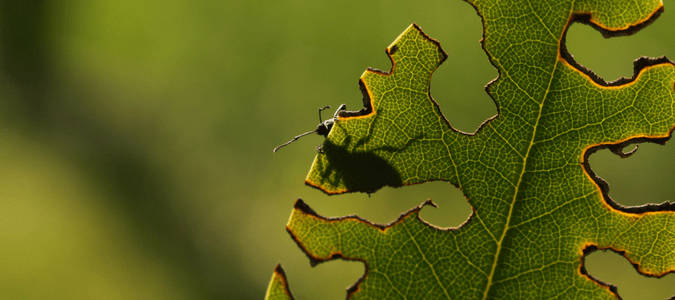
The black vine weevil, also known as the taxus weevil, is a serious threat to gardens across the world—yet many homeowners have never even heard of this insect, which can kill entire trees, starting at the roots. Originally from Europe, the black vine weevil made its debut in the northeastern United States sometime in the mid-nineteenth or early twentieth century. Now, this pest has reached most parts of the U.S., as well as many parts of Europe and Asia, and has earned the reputation of being the most destructive type of root weevil.
Adult black vine weevils particularly love to feed on the leaves of rhododendrons, azaleas, peonies, wisteria and Japanese holly. This can cause cosmetic damage—notches and holes in the plants’ leaves that result in a tattered, moth-eaten appearance—but this isn’t the worst of this pest’s potential for damage. Black vine weevil larvae feed on the roots of many plants, including hemlock trees, yews and other conifers, which can kill the plant over time.
Having any of these types of trees or plants on your property puts you at risk for black vine weevil infestation and damage. If you live in the southern or southwestern part of the U.S., you are at a lower risk for damage, since black vine weevils are less prevalent in warmer areas, whether humid or arid. Still, since this pest has become invasive in other parts of the country, if you have plants in your garden that are susceptible to black vine weevils, it’s a smart idea to learn more about this pest, so you can spot damage and protect your plants.

Black Vine Weevil In House: What To Do When You Find This Pest In Your Home
Black vine weevils have been known to infest commercial plant nurseries, despite professional gardeners’ best efforts to protect the plants. When black vine weevil larvae burrow into a plant’s root structure, it can be difficult to detect their presence until extensive damage has already been done. Many a plant-lover has been dismayed to bring home a beautiful potted plant from a nursery, only to find out later, when the plant unexpectedly begins to wither, that they also brought home unwelcome hitchhiker pests.
If you want to keep black vine weevils out of your home, first you need to know what this insect looks like. When looking for these types of lawn pests, identification is easier when you know that adult black vine weevils look like small beetles. When they first emerge from their pupal stage, their bodies are a medium-brown color, but they quickly darken to dark gray or black. What appears to be small, lighter-brown spots on their backs are actually tiny patches of lighter-colored hair. Adult black vine weevils measure about a centimeter to a half-inch long; this length includes their heads, which have a short snout-like apparatus that they use to burrow and feed. Though black vine weevils do have wings, they are non-flying insects.
Most people who find black vine weevils in their homes find them in or around their indoor potted plants. If you spot any of the following signs, there is a good chance that these insects are living in your home:
- Notches in the leaves of your indoor plants, indicating insect feeding activity.
- Tiny, white or light brown eggs, each no larger than a millimeter across, in the soil at the base of your potted plants.
- Small, white, legless grub larvae in the soil of potted plants or living within the plant’s root structure (these can be spotted, for example, when you are transplanting the plant from its plastic container from the nursery to a permanent planter in your home or greenhouse).
- Small, beetle-looking insects, black or light brown in color, spotted on or near your indoor plants, with elbowed antennae and a small “snout” protruding from the head.
If you do find black vine weevils in your home, the very first thing to do is to remove the affected plants and isolate them from any other plants or trees that might also be vulnerable to these pests. If you find any weevils on the floor or other surfaces, simply pick or sweep them up and toss them into the trash—but not outside! A catch-and-release method isn’t a good idea with these insects, since they can cause real damage to your beautiful plants.
Read on to learn more methods for getting rid of black vine weevils from your home and yard.

Black Vine Weevil Bite: How To Treat It, And When To Worry
Here’s a bit of good news about black vine weevils: They do not bite humans or animals, nor do they sting or carry diseases. They also can’t damage the structure of your home. The only thing they damage is plants and trees—but many homeowners would agree, that’s more than enough destruction. So how can you tell if you have black vine weevil damage outdoors in your yard or garden?

Black Vine Weevil Damage: Signs Of A Garden Infestation
Adult black vine weevils cause aesthetic damage to various types of foliage when they chew notches into the leaves, but the real destructive damage is caused by this insect’s larvae, which feed on the root structures of azaleas, rhododendrons and many types of conifers, along with other plants. Unfortunately, it is easy to miss the signs of black vine weevil damage, especially damage at the root level, until it’s already too late for the affected plant to survive. For this reason, it’s important to know the signs of the presence of black vine weevils in your yard.
Signs of an outdoor black vine weevil infestation are much the same as the signs of an indoor infestation. These include:
- Very small, white or pale brown eggs in the dirt near the stem or base of a plant.
- Chewed notches in the leaves of your trees, shrubs or other plants, which indicate weevil feeding activity.
- Small, white grub larvae in the soil near the base of a plant or tree, or within the plant’s root structure. These may be spotted when you’re transplanting a plant from its flower pot into the ground, or when a plant has died and you’re digging it up to remove it from your yard. Whenever a plant dies and you dig it up, it’s always a good idea to inspect its roots for insect activity, especially if you’re unsure why it died.
- Small, beetle-looking insects with small snouts and elbowed antennae, usually dark gray or black but sometimes light brown in color, spotted on the leaves of your plants or trees. You may also spot them in cracks or crevices in your yard or deck, or in the bases of outdoor planters.
Since these insects are typically most active at night, it can be difficult for gardeners to find them. During the daytime, black vine weevils tend to hide in the bases of planters or flower pots, under leaves, in mulch or soil, or in cracks and crevices in rock walls, decking and other landscaping areas. It’s easier to spot the evidence of adult black vine weevils feeding on plant leaves, or to spot their eggs in the soil at a plant’s base.
In order to spot the signs of black vine weevils in your yard, it is helpful to understand a bit about this insect’s life cycle. Once a female black vine weevil lays her eggs, within less than two weeks, the eggs will hatch into small grubs that burrow into the soil, where they will feed on the plant’s root structure as well as on other dead plant material.
These grubs’ bodies are white, curved and ringed with rows of small golden hairs called setae. They have brown heads and no legs. Black vine weevil grubs can live for anywhere from a couple of months to a year, growing to about a half-inch in length. As they continue feeding on roots and other plant material within the soil, they sometimes bore into larger roots and even the bases of plants. This is the most damaging activity to the plant, since the root structure is how the plant takes in its water and essential nutrients. Black vine weevil larvae can kill even larger shrubs or trees if given the chance to destroy the plant’s roots.
As the seasons progress and winter brings its chilly temperatures, the grub larvae stop feeding, going into a dormant state in the soil through the cold season. When temperatures rise once again in the spring, the larvae will feed one more time before finally entering the pupal stage and then going on to emerge as an adult weevil.
One way to find adult black vine weevils is by setting out sticky traps at the bases of susceptible plants, which will catch the insects when they crawl over the trap. If you find notched leaves, especially on a plant that is known to be susceptible to black vine weevils, you can set out a cloth on the ground below the plant and then either shake the plant or beat it lightly with a broom. If black vine weevils are present, they will fall down onto the cloth.
To find this insect’s larvae, you’ll have to inspect a plant’s roots, which can be difficult or impossible when it comes to plants living outdoors in the ground. This is why so many gardeners and homeowners don’t know there is a problem until it’s too late, when a plant has withered and died due to black vine weevil larvae burrowing into its roots and stems.

How To Get Rid Of Black Vine Weevil
Since female black vine weevils can lay eggs for an extended period, from early summer through mid-fall, all four of this insect’s life stages—eggs, grub larvae, pupae and adult weevils—may be present and active in a particular area at the same time. For this reason, if you have a black vine weevil problem in your home or yard, it is essential to address every stage of the life cycle to ensure that future generations of the insect won’t survive.
Two popular and effective ways of getting rid of black vine weevils involve using various types of insecticides and parasitic nematodes, often in combination with one another. Insecticides can be applied to plants’ foliage, to kill and repel adult weevils, and both insecticides and nematodes can be used as a soil drenching application to kill the insect’s eggs and larvae.
Nematodes are a type of roundworm that are natural parasites capable of killing off black vine weevil eggs and larvae. For nematodes to be most effective in combating black vine weevils, they should be applied to soil that is on the warmer side—between 50 and 85 degrees Fahrenheit. If you use this method to kill off weevils in your yard, be sure to time it right: In spring or early summer, once you’ve noticed the first leaf notches indicating adult black vine weevils, wait a month before applying nematodes to give the grub larvae time to hatch in the soil.
Also be sure not to expose the nematodes to direct sunlight, and to keep the soil moist both before and after nematode application. You’ll also need to water frequently for at least two weeks after applying the nematodes to ensure they have enough moisture to survive. Note that just one nematode application probably won’t be enough; you may need regular applications of nematodes to fully resolve a black vine weevil infestation.
ABC Can Help With Any Pest, Inside Or In Your Yard
Insecticides are another effective way to combat black vine weevils, and there are several different types that can get rid of these pests. If you are among the many homeowners, however, who prefer not to handle insecticide products or insect infestations on your own, ABC Home & Commercial will be happy to help. Our pest control specialists are experienced in combating all types of insect infestations, including black vine weevils, chinch bugs and more, both indoors and outdoors. One of our ABC pest control experts can come inspect your plants to determine whether black vine weevils or some other pest is present. We will then develop a comprehensive, individualized plan to get rid of the pests and protect your plants and trees, so your yard and garden can thrive.
